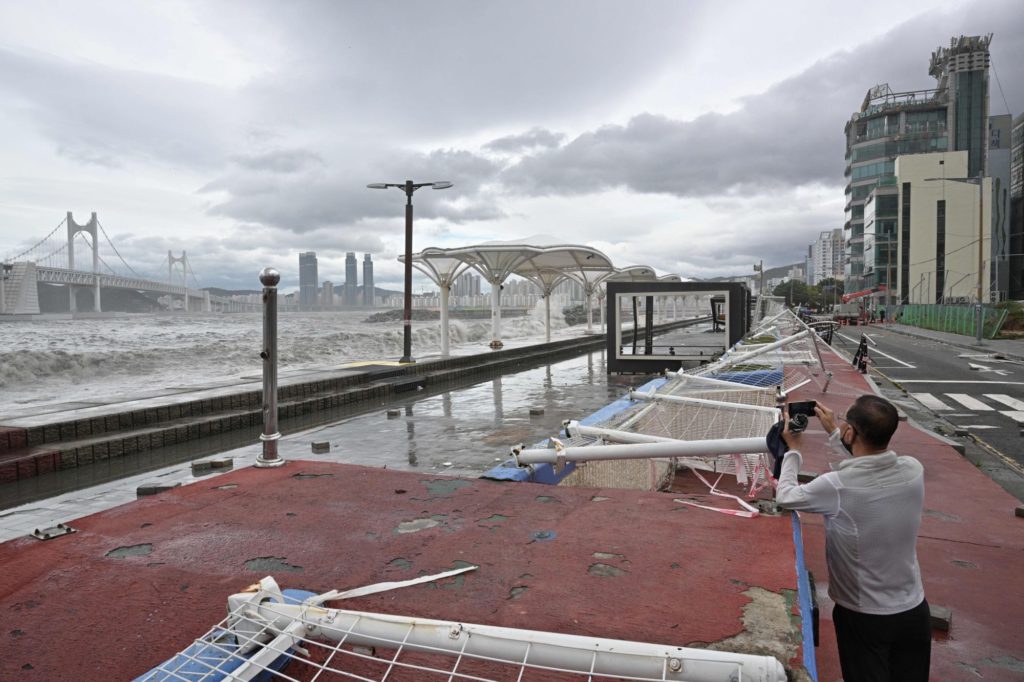Typhoon Hinnamnor left at least two people dead and created flooding and power outages as it passed through South Korea, though the destruction appeared to be less than had been forecast.
(Bloomberg) — Typhoon Hinnamnor left at least two people dead and created flooding and power outages as it passed through South Korea, though the destruction appeared to be less than had been forecast.
Hinnamnor hit near the southern city of Geoje at 4:50 a.m. local time on Tuesday and moved off the coast near Ulsan just a few hours later, the Korea Meteorological Administration said. Projections from the US Joint Typhoon Warning Center show the typhoon moving through Korea’s eastern sea, and potentially making landfall again in eastern Russia.
At least two people were reported killed while at least 10 are missing, according to Yonhap. But South Korea appeared to avoid the worst predictions from what was expected to be the most powerful storm ever to hit the country.
Businesses began to return to normal soon after the storm passed, with flights being restored to Busan and the resort island of Jeju. Companies including Hyundai Motor Co., Hyundai Heavy Industries Co. and Daewoo Shipbuilding & Marine Engineering Co. were ready to resume operations by the afternoon.
Hinnamnor weakened Tuesday afternoon, with sustained winds of about 86 miles (138 kilometers) per hour with gusts around 104 mph, according to the US warning center. Still, the typhoon left its mark on South Korea and even parts of Japan.
More than 3,500 people were evacuated along South Korea’s southern coast, while almost 90,000 homes nationwide suffered power outages as of 3 p.m., Yonhap reported. However, Korea Electric Power Corp. has restored electricity to more than 78,000 homes, Yonhap said.
Kyushu Electric Power Co., the utility provider for Japan’s southwestern prefectures in Kyushu, said that over 30,000 buildings in the region are without power due to the typhoon, while telecommunications providers KDDI Corp. and NTT Docomo said service has been disrupted in some parts of the country.
Posco said its steel plant in Pohang hasn’t resumed production after the storm. The South Korean company, which halted operations at the plant during the worst hours of the typhoon to minimize damages, is investigating how long it will take to restart the facility.
Six nuclear reactors on South Korea’s southeast coast had been running at lower rates ahead of the typhoon. They will operate at a reduced rate for now until the situation returns to normal, according to a spokeswoman at Korea Hydro & Nuclear Power Co.
Oil refiners, chemical operations and the nation’s oldest nuclear power plant had earlier taken precautions amid predictions the typhoon would hammer Jeju and the key industrial city of Ulsan on the country’s southeast coast. Hinnamnor has disrupted port operations, airline services and schools across Asia since developing last month.
The typhoon was the second major storm to batter South Korea in a matter of weeks, after Seoul was hit by the heaviest rains in a century in early August, killing at least 11 people. President Yoon Suk Yeol faced criticism for his response to the floods and apologized to the nation for “inconveniences” caused by the storm.
Yoon, who had promised the government would stay alert to protect the lives and safety of citizens, said Tuesday morning that while the typhoon has made its way out to sea, it’s too early to express relief because areas with damage still need to be rescued.
(Updates with details of typhoon’s impact.)
More stories like this are available on bloomberg.com
©2022 Bloomberg L.P.











